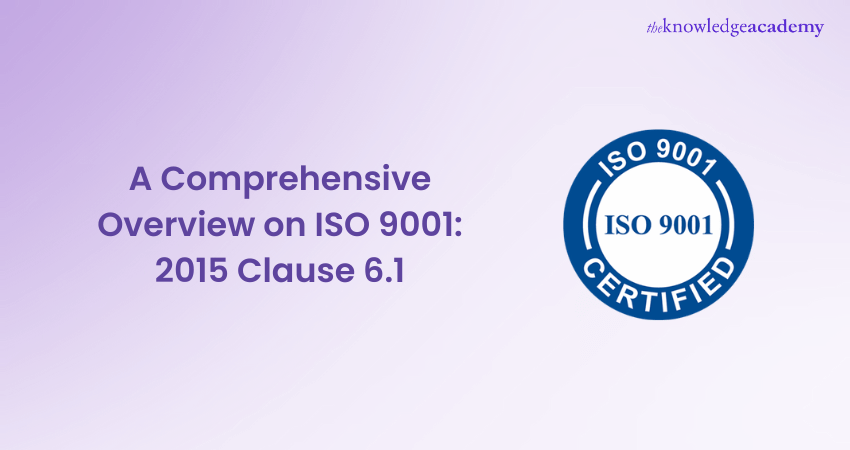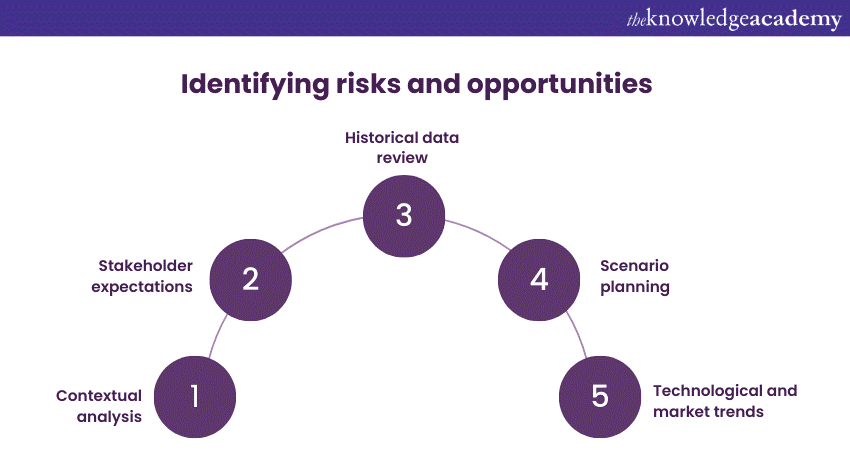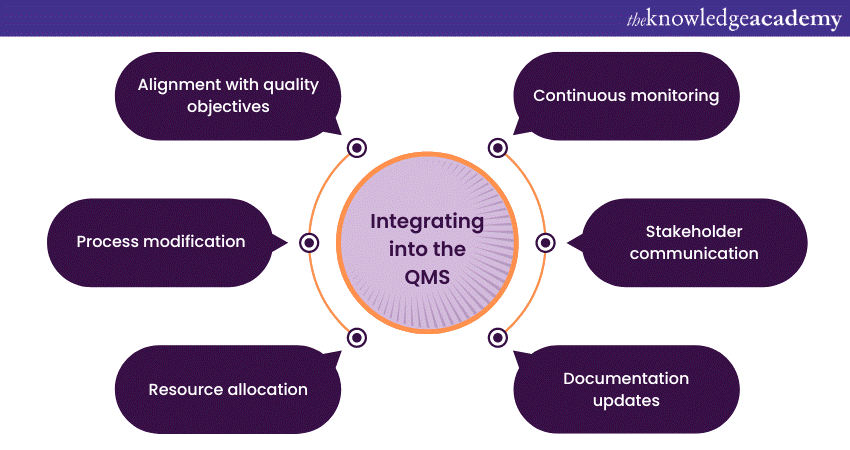We may not have the course you’re looking for. If you enquire or give us a call on 0800 446148 and speak to our training experts, we may still be able to help with your training requirements.
Training Outcomes Within Your Budget!
We ensure quality, budget-alignment, and timely delivery by our expert instructors.

Picture navigating the vast ocean aboard a ship your success depends on your ability to adeptly manage the risks of unpredictable seas and capitalise on favourable winds. This is the essence of ISO 9001:2015 Clause 6.1, your navigational chart for Quality Management.
It’s not just a set of rules; it's a strategic framework designed to guide organisations through the choppy waters of market uncertainties and competitive pressures. Let's dive in and understand ISO 9001:2015 Clause 6.1.
Table of Contents
1) Understanding ISO 9001 2015 Clause 6.1
a) Importance of Clause 6.1
b) Identifying risks and opportunities
c) Risk assessment process
d) Integrating into the QMS
2) Benefits of implementing Clause 6.1 ISO 9001
3) Conclusion
Understanding ISO 9001 2015 Clause 6.1
Clause 6.1 ISO 9001 stands at the heart of planning a successful QMS. Let's look into its intricacies:
Importance of Clause 6.1
Since Clause 6.1 is essential to proactive organisational planning, the ISO 9001 2015 gives it special attention. This clause highly emphasises why an organisation must handle opportunities and risks in a methodical and organised manner. Let us examine Clause 6.1's significance in detail:
a) Emphasis on risk-based thinking: The contemporary business environment necessitates a proactive approach. Hence, Clause 6.1 introduces risk-based thinking and urges organisations to anticipate and address potential challenges and opportunities in advance. This shift from reactive to proactive thinking is vital in navigating today's unpredictable market dynamics.
b) Alignment with strategic direction: Clause 6.1 facilitates the alignment of identifying and assessing opportunities and risks with the strategic objectives of an organisation. This guarantees that the QMS is inextricably linked to the organisation's overarching objectives, leading to logical and cohesive action.
c) Ensuring continual improvement: An inherent characteristic of Clause 6.1 within ISO 9001 Principles is its cyclical nature. By continually identifying risks and opportunities, assessing their potential impacts, and integrating the findings into the QMS, organisations are perpetually on a path of improvement. This continual evolution is pivotal for businesses to stay competitive and relevant.
d) Building stakeholder confidence: By systematically addressing risks and opportunities, organisations can demonstrate to stakeholders, customers, suppliers, or investors that they are committed to quality and excellence. This not only bolsters reputation but also instils confidence in the organisation's products, services, and brand.
Identifying risks and opportunities
Clause 6.1 of ISO 9001 2015 mostly emphasises the need to identify opportunities and hazards. In order for an organisation to succeed, this further ensures anticipating opportunities and difficulties rather than acknowledging them. Let’s look at some more points to understand them:

a) Contextual analysis: Gaining a complete grasp of the organisation's context is a prerequisite in recognising dangers and opportunities. This entails considering both internal and external elements, including as market dynamics, technical advancements, and regulatory changes, as well as organisational culture, resources, and operational skills. In ISO 9001 Internal Audits, understanding these factors is crucial for effective assessment.
b) Stakeholder expectations: Interacting with stakeholders—which include clients, vendors, staff members, and even government authorities—can yield insightful information. Their viewpoints and expectations may draw attention to possibilities to resolve unfulfilled requests or possible hazards associated with failing to meet their needs.
c) Historical data review: Past performance data, including non-conformities, audit results, or customer feedback often found in the ISO 9001 Audit Checklist, can be a goldmine of information. By analysing historical data, organisations can spot recurring patterns, identify inherent vulnerabilities, and uncover areas of potential innovation or expansion.
d) Scenario planning: Forecasting possible hazards and opportunities can be aided by "what if" scenario analysis. Anticipating the potential effects of legislative changes or new market entrants, for example, can help an organisation get ready to take advantage of possibilities or minimise obstacles.
e) Technological and market trends: Emerging technologies, evolving customer preferences, and market trends can unveil opportunities for product development or reveal risks associated with obsolescence.
Enhance your knowledge of ISO 9001 Standards and improve your performance with the ISO 9001 Foundation Course!
Risk assessment process
Within the ISO 9001 2015 framework, especially in Clause 6.1, the risk assessment process stands out as a crucial step. It goes beyond merely identifying risks and dives deep into analysing their implications, allowing organisations to prioritise and formulate mitigation strategies. Here's a closer look at the structured approach to risk assessment:
a) Risk identification: Risk identification involves spotting potential threats or challenges that could affect the organisation’s objectives. Using tools such as brainstorming sessions, SWOT Analysis, or stakeholder interviews can be instrumental in collating a comprehensive list of risks.
b) Risk analysis: Once identified, each risk must be scrutinised for its potential impact and likelihood of occurrence. At this juncture, quantitative methods like statistical analysis or qualitative approaches such as expert judgment come into play. The aim is to understand the severity of each risk and its probable consequences.
c) Risk evaluation: Following analysis, risks are then ranked or prioritised based on their potential impact and likelihood. This step helps in discerning which risks demand immediate attention, which can be accepted, and which may require further monitoring.
d) Risk treatment: Post evaluation, organisations devise strategies to manage or mitigate the identified risks. These strategies range from risk avoidance, where certain activities are halted to prevent the risk and actions are taken to minimise its potential impact.
e) Monitoring and review: Risk landscapes are dynamic, and therefore, continuous monitoring is essential. By periodically reviewing the risk assessment, organisations can ensure that new risks do not blindside them and that mitigation strategies remain effective.
f) Communication: All stakeholders, including employees, management, and external partners, should be made aware of the identified risks, their implications, and the strategies in place to manage them.
Unlock quality excellence with our ISO 9001 Training!
Integrating into the QMS
In ISO 9001 2015 Clause 6.1, once risks and opportunities are identified and assessed, their effective integration into the QMS is essential. Here's a comprehensive examination of this integration process:

a) Alignment with quality objectives: The primary essence of integrating risks and opportunities is to ensure that they align cohesively with the organisation's quality objectives. This means that any threat or opportunity identified should have a corresponding strategy or action that either mitigates or leverages it, ensuring that the quality objectives remain achievable.
b) Process modification: Risks and opportunities often necessitate changes in organisational processes. For instance, a risk associated with a production process may require the process to be re-engineered or modified. Conversely, a newfound opportunity in the market might demand the acceleration of a particular production line. Integrating these insights into the QMS often translates into tangible process changes.
c) Resource allocation: The identified risks and opportunities might require an organisation to rethink its resource allocation. High-priority risks might need additional personnel or financial resources for mitigation, while lucrative opportunities could demand increased investment or capital reallocation.
d) Documentation updates: An effective QMS thrives on comprehensive ISO 9001 Documentation. Integrating risks and opportunities implies updating processes, policies, and procedural manuals to reflect the changes. This ensures consistency, clarity, and a documented trail for future ISO Audits or reviews.
e) Stakeholder communication: Any update or integration needs to be shared with everyone to be successful. This covers the internal stakeholders as well as any relevant external partners, suppliers and customers.
f) Continuous monitoring: The QMS framework should be used to continuously monitor the integrated risks and opportunities. Considering changes and insights obtained in real-time guarantees that the organisation maintains its agility. Lead the way in Quality Management with our ISO 9001 Lead Implementer Certification
Lead the way in Quality Management with the ISO 9001 Lead Implementer Certification.
Benefits of implementing Clause 6.1 ISO 9001
The incorporation of Clause 6.1 in ISO 9001 2015 underscores the emphasis on risk-based thinking. Implementing this clause brings a slew of advantages that elevate an organisation's operational and strategic approach. Let us get into these Benefits of ISO 9001:
a) Proactive approach: Rather than being reactionary, organisations become adept at foreseeing challenges and opportunities. This bold stance minimises unexpected setbacks and capitalises on favourable circumstances.
b) Enhanced stakeholder confidence: Demonstrating a systematic approach to risk boosts the confidence of stakeholders. Customers, suppliers, and investors view the organisation as one that is committed to quality and operational excellence.
c) Strategic alignment: By ensuring that risks and opportunities are aligned with the organisation's goals, Clause 6.1 facilitates a cohesive strategy where every department and process moves in tandem towards shared objectives.
d) Resource optimisation: With clear insights into potential risks and opportunities, organisations can allocate resources more effectively. This ensures that crucial areas receive adequate attention, manpower, and investment.
e) Continuous improvement: The inherent cyclical nature of Clause 6.1, focusing on identification, assessment, and integration, guarantees that the organisation is on a perpetual path of refinement and growth, maintaining the ISO Quality Standards.
f) Competitive edge: Organisations are equipped with a systematic approach to manage risks and seize opportunities that often outpace their competitors, ensuring longevity and market dominance.
Master the art of quality auditing with the ISO 9001 Certification Course.
Conclusion
Beyond being a prerequisite for the ISO 9001 Standard, ISO 9001:2015 Clause 6.1 has further uses. It is an effective instrument that motivates businesses to adopt an innovative mindset. This can help companies create long-term growth conditions and ongoing improvement by recognising and evaluating opportunities and risks.
Empower your organisation's quality standards with our ISO 9001 Internal Auditor Course.
Frequently Asked Questions

According to ISO 9001, there are numerous ways to audit opportunities as well as risks. The common ones among them include understanding the risks’ nature and using established risk mitigation approaches. Additionally, you must use simpler risk management approaches and techniques.

A risk refers to an unforeseen event that could potentially harm your project. An opportunity, on the other hand, denotes an unexpected occurrence that can be leveraged to benefit your project positively.

The Knowledge Academy takes global learning to new heights, offering over 30,000 online courses across 490+ locations in 220 countries. This expansive reach ensures accessibility and convenience for learners worldwide.
Alongside our diverse Online Course Catalogue, encompassing 17 major categories, we go the extra mile by providing a plethora of free educational Online Resources like News updates, Blogs, videos, webinars, and interview questions. Tailoring learning experiences further, professionals can maximise value with customisable Course Bundles of TKA.

The Knowledge Academy’s Knowledge Pass, a prepaid voucher, adds another layer of flexibility, allowing course bookings over a 12-month period. Join us on a journey where education knows no bounds.

The Knowledge Academy offers various ISO 9001 Certifications, including the ISO 9001 Foundation Course, ISO 9001 Lead Auditor Course, and ISO 9001 Internal Auditor Training. These courses cater to different skill levels, providing comprehensive insights into the Integration Architect Skills.
Our Business Improvement Blogs cover a range of topics related to ISO 9001 Requirements, offering valuable resources, best practices, and industry insights. Whether you are a beginner or looking to advance your Business skills, The Knowledge Academy's diverse courses and informative blogs have got you covered.
Upcoming Business Improvement Resources Batches & Dates
Date
 ISO 9001 Foundation course
ISO 9001 Foundation course
Mon 25th Nov 2024
Mon 10th Feb 2025
Mon 7th Apr 2025
Mon 2nd Jun 2025
Mon 11th Aug 2025
Mon 13th Oct 2025
Mon 8th Dec 2025







 Top Rated Course
Top Rated Course



 If you wish to make any changes to your course, please
If you wish to make any changes to your course, please


